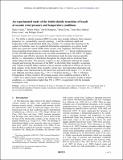An experimental study of the brittle-ductile transition of basalt at oceanic crust pressure and temperature conditions
Author(s)
Violay, Marie; Gibert, Benoit; Mainprice, David; Dautria, Jean-Marie; Azais, Pierre; Pezard, Philippe; Evans, James Brian; ... Show more Show less
DownloadEvans_An experimental.pdf (1.983Mb)
PUBLISHER_POLICY
Publisher Policy
Article is made available in accordance with the publisher's policy and may be subject to US copyright law. Please refer to the publisher's site for terms of use.
Terms of use
Metadata
Show full item recordAbstract
The brittle to ductile transition (BDT) in rocks may strongly influence their transport properties (i.e., permeability, porosity topology…) and the maximum depth and temperature where hydrothermal fluids may circulate. To examine this transition in the context of Icelandic crust, we conducted deformation experiments on a glassy basalt (GB) and a glass-free basalt (GFB) under oceanic crust conditions. Mechanical and micro-structural observations at a constant strain rate of 10[superscript −5] s[superscript −1] and at confining pressure of 100–300 MPa indicate that the rocks are brittle and dilatant up to 700–800°C. At higher temperatures and effective pressures the deformation mode becomes macroscopically ductile, i.e., deformation is distributed throughout the sample and no localized shear rupture plane develops. The presence of glass is a key component reducing the sample strength and lowering the pressure of the BDT. In the brittle field, strength is consistent with a Mohr-Coulomb failure criterion with an internal coefficient of friction of 0.42 for both samples. In the ductile field, strength is strain rate- and temperature-dependent and both samples were characterized by the same stress exponent in the range 3 < n < 4.2 but by very different activation energy Q[subscript GB] = 59 ± 15 KJ/mol and Q[subscript GFB] = 456 ± 4 KJ/mol. Extrapolation of these results to the Iceland oceanic crust conditions predicts a BDT at ∼100°C for a glassy basalt, whereas the BDT might occur in non-glassy basalts at deeper conditions, i.e., temperatures higher than 550 ± 100°C, in agreement with the Icelandic seismogenic zone.
Date issued
2012-03Department
Massachusetts Institute of Technology. Department of Earth, Atmospheric, and Planetary SciencesJournal
Journal of Geophysical Research: Solid Earth
Publisher
American Geophysical Union (AGU)
Citation
Violay, Marie et al. “An Experimental Study of the Brittle-Ductile Transition of Basalt at Oceanic Crust Pressure and Temperature Conditions: BRITTLE-DUCTILE TRANSITION OF BASALT.” Journal of Geophysical Research: Solid Earth 117.B3 (2012): n. pag. © 2012 by the American Geophysical Union
ISSN
2169-9356
2169-9313